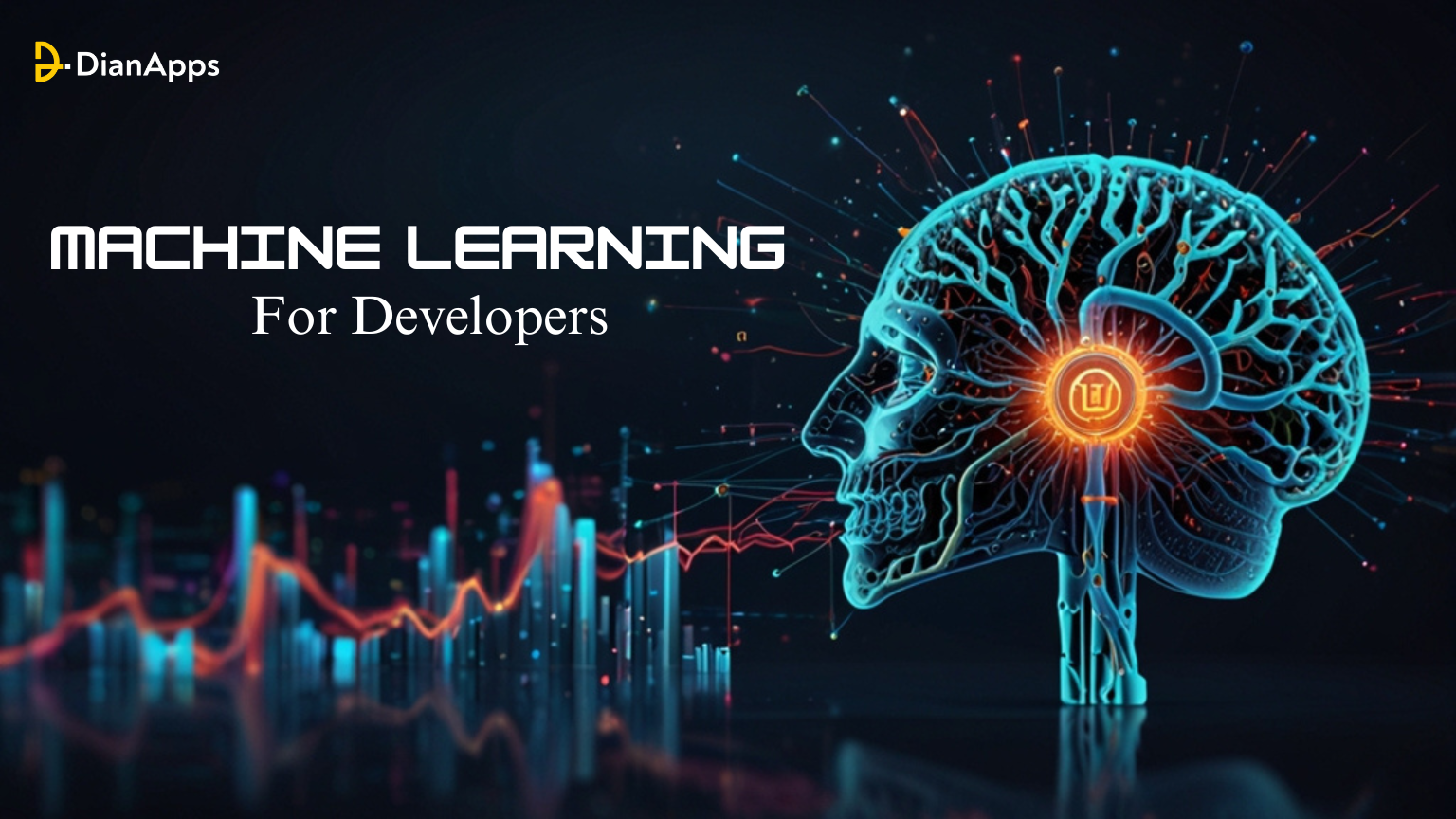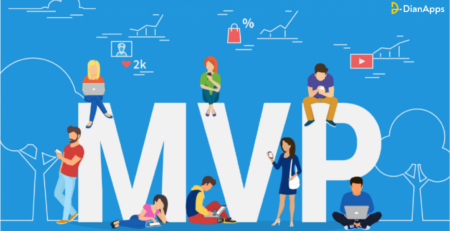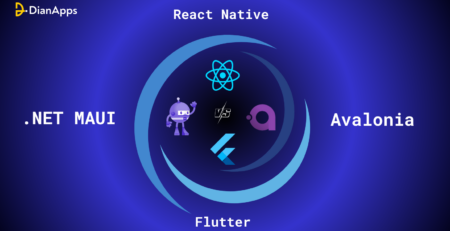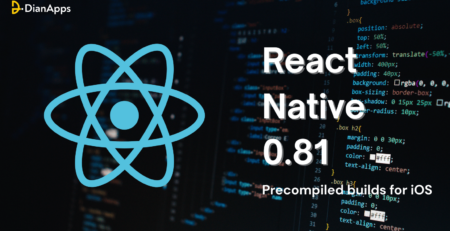Machine Learning for Developers: A 2025 Guide to Building Smarter Applications
According to recent findings of Statista, approximately 90% of the world’s data has been generated in just the past two years. With the increased use of digital interactions, businesses are relying on machine learning to automate processes, analyze vast amounts of data, and deliver intelligent user experiences.

From AI-generated recommendation engines to predictive analytics in healthcare and finance, machine learning is no longer a futuristic concept; it’s shaping the present. In fact, the global machine-learning market is expected to reach $209.91 billion by 2025, growing at a CAGR of 39.4%.
For developers, the question is no longer, “Should I learn machine learning?” but rather, “How can I effectively integrate ML into my application?” This blog will guide you through essential tools, challenges, key concepts, and future trends to help you build smarter applications in 2025.
If you want to integrate ML technologies into your software, partnering with a leading custom software development company with expertise in ML technologies can make all the difference.
Key Machine Learning Concepts Every Developer Should Know
Before getting deep insights into ML-powered development, it is essential to grasp the fundamental concepts. Here are some important ML principles that every developer must understand:
Supervised vs. Unsupervised Learning
- Supervised Learning: This concept involves labeled data, where the model learns from input-output pairs such as fraud detection and spam detection.
- Unsupervised Learning: It works with unlabeled data to find clusters and patterns, such as anomaly detection and customer segmentation.
- Semi-supervised learning: This concept uses both labeled and unlabeled data, enhancing model accuracy with fewer labeled examples.
Neural Networks and Deep Learning
- Neural networks are inspired by human brains, which help in processing complex patterns.
- Some of the popular deep learning models are used in modern applications, some as CNNs (for image recognition), and RNNs (for sequence-based tasks).
- Cutting-edge AI applications are driven by transformers like GPT, which make generative AI and powerful NLP possible.
Natural Language Processing (NLP)
- For popular automated applications such as voice assistants, sentiment analysis tools, and chatbots. For these applications, NLP enables computers to understand human language.
- Popular techniques such as named entity recognition (NER), tokenization, and text embeddings help in extracting meaning from text data.
Reinforcement Learning
- Reinforcement learning allows models to improve through trial and error, this concept is majorly used in robotics, self-learning systems, and gaming.
- A few popular reinforcement learning methods are Proximal Policy Organization (PPO) and Deep Q-Networks (DQNs).
Feature Engineering and Data Preprocessing
- Model performance can majorly be determined by high-quality features. Feature dimensionality reduction, normalization, and scaling play a critical role in optimizing ML models.
- Businesses can even adopt automated feature selection techniques like Principal Component Analysis (PCA) to help improve efficiency.
Overfitting and Underfitting
- Overfitting is required when a model performs well with training data but fails on unseen data.
- Underfitting occurs when the model is too simple to capture the underlying pattern in data.
- These issues can be addressed with the help of techniques such as cross-validation, dropout layers, and regularization.
Essential Machine Learning Tools and Frameworks for Developers
To streamline the data collection process for training machine learning models, you can also leverage tools that automate data scraping and processing. For example, AI data collection: How to feed your LLM using platforms like Apify can help gather structured data for model training quickly and efficiently.
TensorFlow & PyTorch
- TensorFlow: This is an open-source Google framework that is ideal for production-grade deep learning applications.
- PyTorch: Due to its dynamic computation graphs, it is preferred for rapid research prototyping.
Recommended Read: Top AI Tools Revolutionizing App Development in 2025
Scikit-Learn
- It can be considered a lightweight library for traditional ML tasks for classification, clustering, and regression.
- For activities such as data preprocessing and model evaluation, it has built-in tools.
AutoML Platforms (Google AutoML, H2O.ai, DataRobot)
- It is used to automate hyper-parametric tuning, deployment, and model selection.
- This platform is considered the best choice for developers who want to implement ML with minimal manual intervention.
ML in Cloud Services
- Some cloud-based platforms, such as Google AI Platform, Azure AI, and AWS SageMaker, offer pre-trained models and scalable ML workflows.
- It reduces the need for expensive on-premise computing resources.
MLOps Tools (Kubeflow, MLflow)
- This tool ensures version control, reproducibility, and automated deployment of ML models.
- This practice is essential for scaling ML workflows in production environments.
ONNX (Open Neural Network Exchange)
- A framework-agnostic model format allows interoperability between different ML platforms.
- It allows developers to train a model in one framework and deploy it in another.
How to Integrate Machine Learning Into Your Applications
If you are planning to integrate ML into your application, understand that it requires a structured approach to ensure accuracy and efficiency. Here are some key steps that you must follow:
Define the Problem and Goals
- The first and foremost step is identifying a business problem where ML can add value (such as sentiment analysis, recommendation systems, and fraud detection).
- To evaluate performance, be sure to define measurable success metrics such as precision, recall, F1-score, or accuracy.
Gather and Preprocess Data
- Data is considered the primary aspect of ML. Ensure that it is structured, clean, and free of bias.
- To improve data accuracy, we can apply innovative features such as feature engineering, outlier detection, and data augmentation.
- To maintain data consistency, normalize, standardize, and handle missing values.
Choose the Right Model
- Now comes the most effective stage selection of a pre-trained model for quick deployment or training a custom model for specific needs.
- Always consider trade-offs between accuracy, computational cost, and interpretability.
- While working with complex tasks like image recognition or NLP, use transfer learning.
Train and Evaluate the Model
- To avoid overfitting, ensure split data into validation, test sets, and training
- To optimize performance, use techniques such as hyperparameter tuning and cross-validation.
- Performance can be monitored using evaluation metrics like Mean Squared Error (MSE), ROC-AUC, or Confusion Matrix.
Deploy and Monitor the Model
- Based on application needs, deploy using cloud services, embedded models, or APIs.
- Continuously monitor for bias, data drift, and performance degradation.
- To compare different model versions and improve reliability, it is mandatory to implement A/B testing.
Optimize for Scalability and Maintenance
- To automate model retraining and deployment, it uses MLOps frameworks.
- Leverage version control for models and data pipelines to track changes.
- Monitor real-world performance and user feedback to refine predictions over time.
Developers can seamlessly integrate ML into their applications by following the structured steps shown above. These steps can also be used to enhance functionality, intelligence, and automation.
Challenges Developers Face in Machine Learning
Though machine learning (ML) has multiple opportunities, developers come across various challenges. Here, you will come across some key limitations that developers face while implementing machine learning in applications.
Data Quality and Availability
The availability of biased or poor-quality data will lead to inaccurate predictions. There are multiple ways to overcome this challenge, like synthetic data generation and data augmentation techniques. These techniques are used to address data scarcity and improve model performance.
Model Interpretability
Most ML models, especially deep learning networks, function as black boxes, making decisions hard to interpret. Interpretation transparency can be enhanced by using Explainable AI (XAI), such as LIME and SHAP.
Computational Costs
For the training of complex ML models, developers usually require high processing power, they often require expensive TPUs and GPUs. Cloud-based ML services help mitigate costs by offering scalable computing resources on demand.
Ethical Considerations and Bias
Biases from data used for training may be transmitted by AI models, producing unjust results. To guarantee moral AI implementations, developers must use fairness requirements and bias detection techniques.
Security and Privacy Concerns
ML applications often come across sensitive data. Techniques like federated learning and differential privacy allow models to learn without enhancing data security and exposing personal information.
By overcoming all these challenges, developers can build more reliable and fair ML-powered applications.
Future Trends: What’s Next for Machine Learning in Software Development?
Machine learning is continuously evolving, bringing new technologies and trends in the software development industry. As we are into 2025, here are some important trends that developers should focus on:
Edge AI and On-Device Learning
Edge AI is constantly evolving its capabilities and becoming a significant trend with an increasing demand for real-time processing and reduced latency. Machine learning models can directly be deployed on devices such as IoT devices, smartphones, and embedded systems with the help of the Edge AI.
Edge AI eliminates the need for cloud-based computations to improve response times and enables applications like autonomous vehicles, healthcare monitoring, and smart assistants to function efficiently without a continuous internet connection. While maintaining high accuracy and performance, developers will need to optimize their ML models for smaller hardware footprints.
Generative AI and Large Language Models (LLMs)
Generative AI, powered by Large Language Models (LLMs), is continuously changing software development by automating code generation, content creation, and data synthesis.
Furthermore, tools like Google’s Gemini, OpenAI’s GPT, and Meta’s LLaMA enable developers to create sophisticated applications that can generate human-like images, text, and even software code.
Today, our major focus shifts toward making these models more interpretable, efficient, and adaptable to specific industries. Here, developers will need to fine-tune LLMs to fit specialized use cases while ensuring ethical AI usage and minimizing biases.
Quantum Machine Learning (QML)
Quantum computing can change machine learning by dramatically speeding up complex computations. This ML algorithm can process massive datasets and optimize model training far beyond the capabilities of classical computing.
With the maturity of quantum hardware, developers will need to explore hybrid approaches that combine classical ML techniques with quantum algorithms to solve problems in cryptography, financial modeling, and material science. Although in the early stages, QML holds immense potential for industries requiring computational power.
Explainable AI (XAI) and Ethical AI
The advent of AI in the software development market is continuously expanding, and so are concerns about its fairness, accountability, and transparency. The major role of explainable AI is to make machine learning models more interpretable, allowing developers and stakeholders to understand how decisions are made.
Explainable AI is mostly used in sensitive sectors such as finance, law, and healthcare, where AI-driven decisions must be unbiased and explainable. To make sure their ML models comply with legal and ethical criteria, developers must include interpretability frameworks, reduce bias strategies, and use fairness-checking tools.
AutoML and No-Code AI Development
Automated machine learning has changed the process of AI development by allowing non-experts to build and deploy ML models without deep technical knowledge. Platforms such as H2O.ai, DataRobot, and Google AutoML provide automated hyperparameter tuning, deployment capabilities, and model selection by enabling faster and more efficient ML adoption.
An increase in AI-powered applications allows businesses to leverage no-code or low-code ML solutions, reducing time to market and development costs. Developers play a crucial role in integrating and customizing these AI-driven solutions into real-world applications.
AI-Augmented Software Development
The software development process can be transformed by leveraging AI-powered tools for automation in coding, testing, and debugging processes. Some platforms, such as Tabnine and GitHub Copilot, assist developers by suggesting code completions, optimizing performance, and identifying errors.
In the current landscape, AI-driven development environments will become more advanced, allowing programmers to deploy and write applications more efficiently. The integration of AI in software development does not replace developers but is used to enhance productivity, allowing them to focus on more complex problem-solving innovations.
Federated Learning for Privacy-Preserving AI
Federated learning is becoming an important framework in machine learning as worries about data security and privacy grow. This type of learning allows ML models to be built across numerous devices without sending raw data, in contrast to typical centralized training. This method improves privacy while enabling organizations to use decentralized data sources to create strong AI models.
Federated learning will be used more frequently in applications such as financial services, healthcare, and personalized recommendations to use the power of machine learning and adhere to strict data protection laws.
AI in Cybersecurity and Fraud Detection
Cyber threats are becoming more sophisticated, necessitating AI-driven cybersecurity solutions. Machine learning models are increasingly being used to detect anomalies, identify potential cyber-attacks, and enhance fraud detection mechanisms.
AI-powered security systems analyze vast amounts of network data in real time, helping organizations prevent security breaches before they occur. Developers working in cybersecurity will need to focus on building adaptive AI models that continuously learn from evolving threats and improve their detection capabilities.
Sustainable and Green AI
As machine learning models grow in complexity, their energy consumption also increases, raising concerns about environmental sustainability. Green AI focuses on optimizing model training and inference to reduce carbon footprints.
Researchers and developers are exploring energy-efficient AI architectures, low-power hardware accelerators, and algorithmic optimizations to create sustainable AI solutions. In this digital landscape, companies will prioritize environmentally friendly ML development practices to align with global sustainability goals.
Final Words
Machine learning is no longer considered an option, it has become a necessity for developers. It is considered an essential skill in modern software development. Understanding the key concepts, leveraging the right tools, and staying informed about emerging trends allow developers to build more efficient and intelligent applications.
As we already began our journey in 2025, ML integration will continue to grow, bringing new possibilities across industries. Are you ready to integrate machine learning into your application? Make sure to connect with a mobile app development company to stay ahead in this competitive market.




